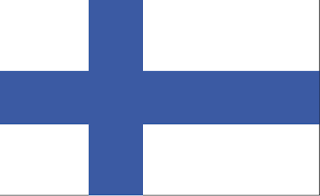Friday, 8 October 2010
History of Finland
The origins of the Finnish people are still a matter of conjecture, although many scholars argue that their original home was in what is now west-central Siberia. The Finns arrived in their present territory thousands of years ago, pushing the indigenous Lapps into the more remote northern regions. Finnish and Lappish--the language of Finland's small Lapp minority--both are Finno-Ugric languages and are in the Uralic rather than the Indo-European family.
Finland's nearly 700-year association with the Kingdom of Sweden began in 1154 with the introduction of Christianity by Sweden's King Eric. During the ensuing centuries, Finland played an important role in the political life of the Swedish-Finnish realm, and Finnish soldiers often predominated in Swedish armies. Finns also formed a significant proportion of the first "Swedish" settlers in 17th-century America.
Following Finland's incorporation into Sweden in the 12th century, Swedish became the dominant language, although Finnish recovered its predominance after a 19th-century resurgence of Finnish nationalism. Publication in 1835 of the Finnish national epic, The Kalevala--a collection of traditional myths and legends--first stirred the nationalism that later led to Finland's independence from Russia.
In 1809, Finland was conquered by the armies of Czar Alexander I and thereafter remained an autonomous grand duchy connected with the Russian Empire until the end of 1917. On December 6, 1917, shortly after the Bolshevik Revolution in Russia, Finland declared its independence. In 1918, the country experienced a brief but bitter civil war that colored domestic politics for many years. During World War II, Finland fought the Soviet Union twice--in the Winter War of 1939-40 and again in the Continuation War of 1941-44. This was followed by the Lapland War of 1944-45, when Finland fought against the Germans as they withdrew their forces from northern Finland.
Treaties signed in 1947 and 1948 with the Soviet Union included obligations and restraints on Finland vis-a-vis the U.S.S.R. as well as territorial concessions by Finland; both have been abrogated by Finland since the 1991 dissolution of the Soviet Union.
Finland's proportional representation system encourages a multitude of political parties and has resulted in many coalition governments. Political activity by communists was legalized in 1944, and although four major parties have dominated the postwar political arena, none now has a majority position. The Center Party (Keskusta), traditionally representing rural interests, gained a slight plurality in Finland's parliament in the general election of March 2003, narrowly defeating the ruling Social Democratic Party (SDP) by a 24.7% to 24.5% margin. The Center then formed a three-party governing coalition with the SDP and the Swedish People's Party. The Green Party, which had withdrawn from the government in spring 2002 in protest to the government decision to approve building a fifth nuclear reactor, remained in the opposition, as did the National Coalition Party (conservatives). The National Coalition leads the opposition in Parliament. The Left Alliance, a combination of socialists left of the SDP and a number of former communists, maintains representation in Parliament but is not a significant factor in most policy decisions.
The Center Party's leader, Anneli Jäätteenmäki, became Finland's first female prime minister in April 2003. However, she resigned amid a scandal over the leak of classified materials 2 months after taking office. She was replaced as prime minister by the Center Party's new chairman, Matti Vanhanen.
Subscribe to:
Post Comments (Atom)

No comments:
Post a Comment